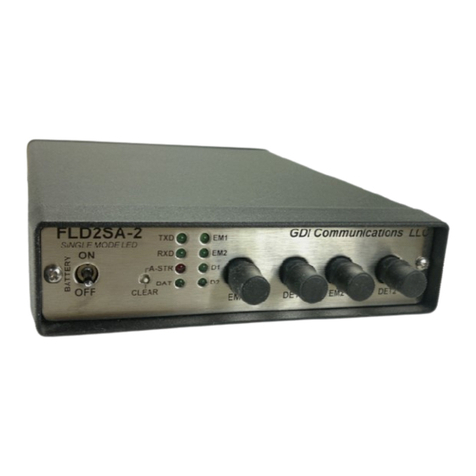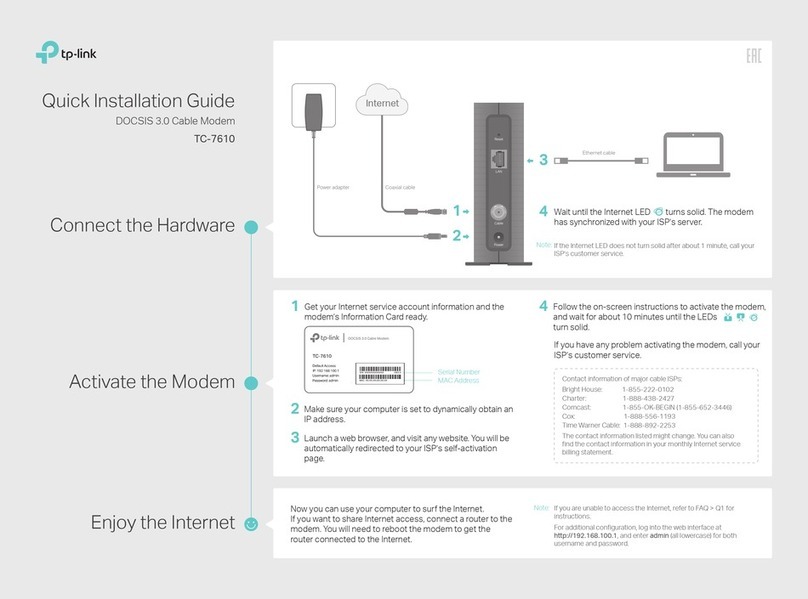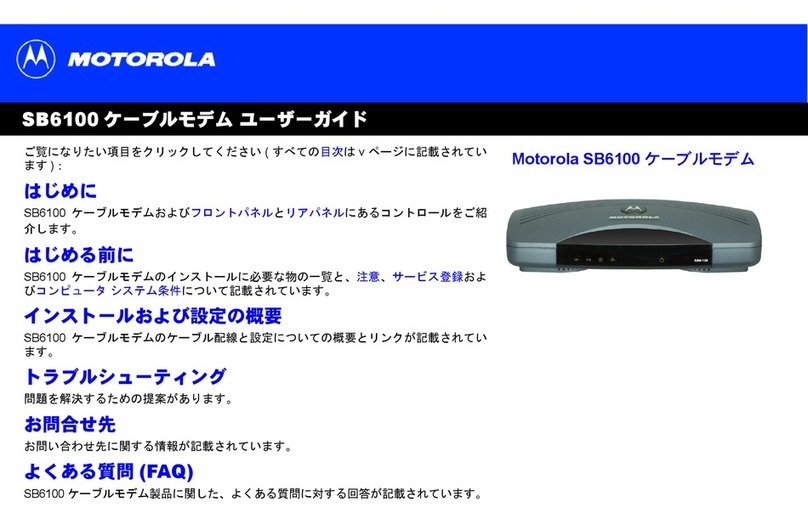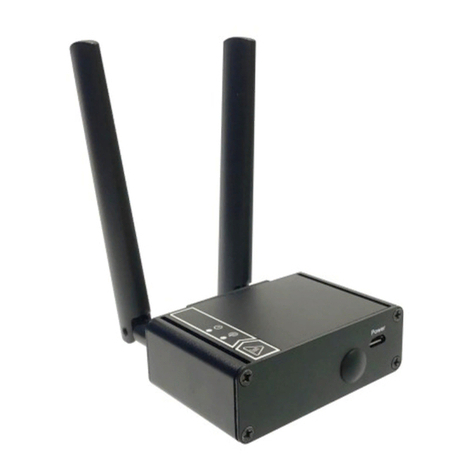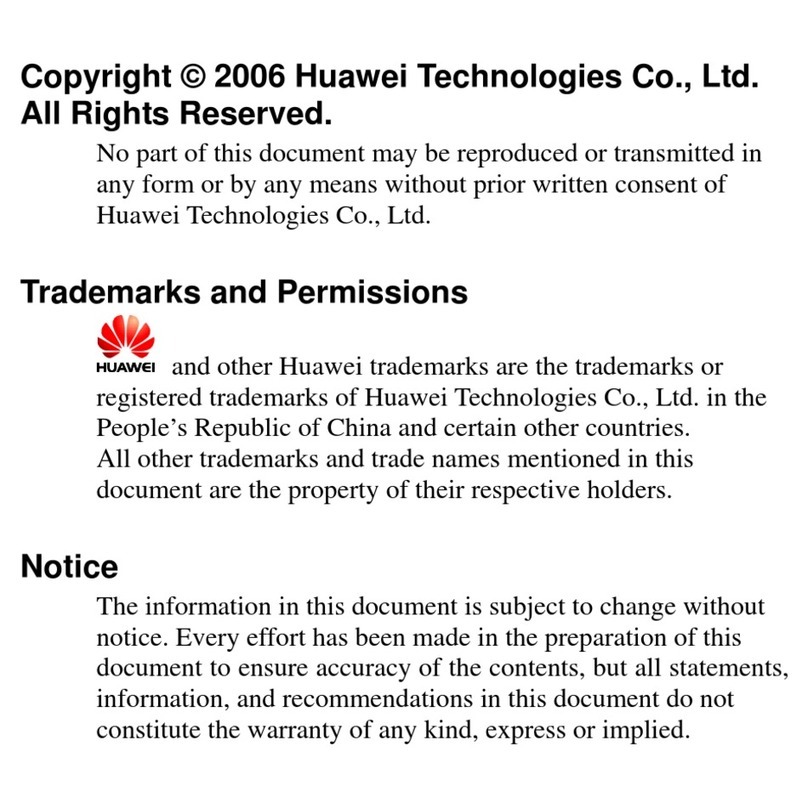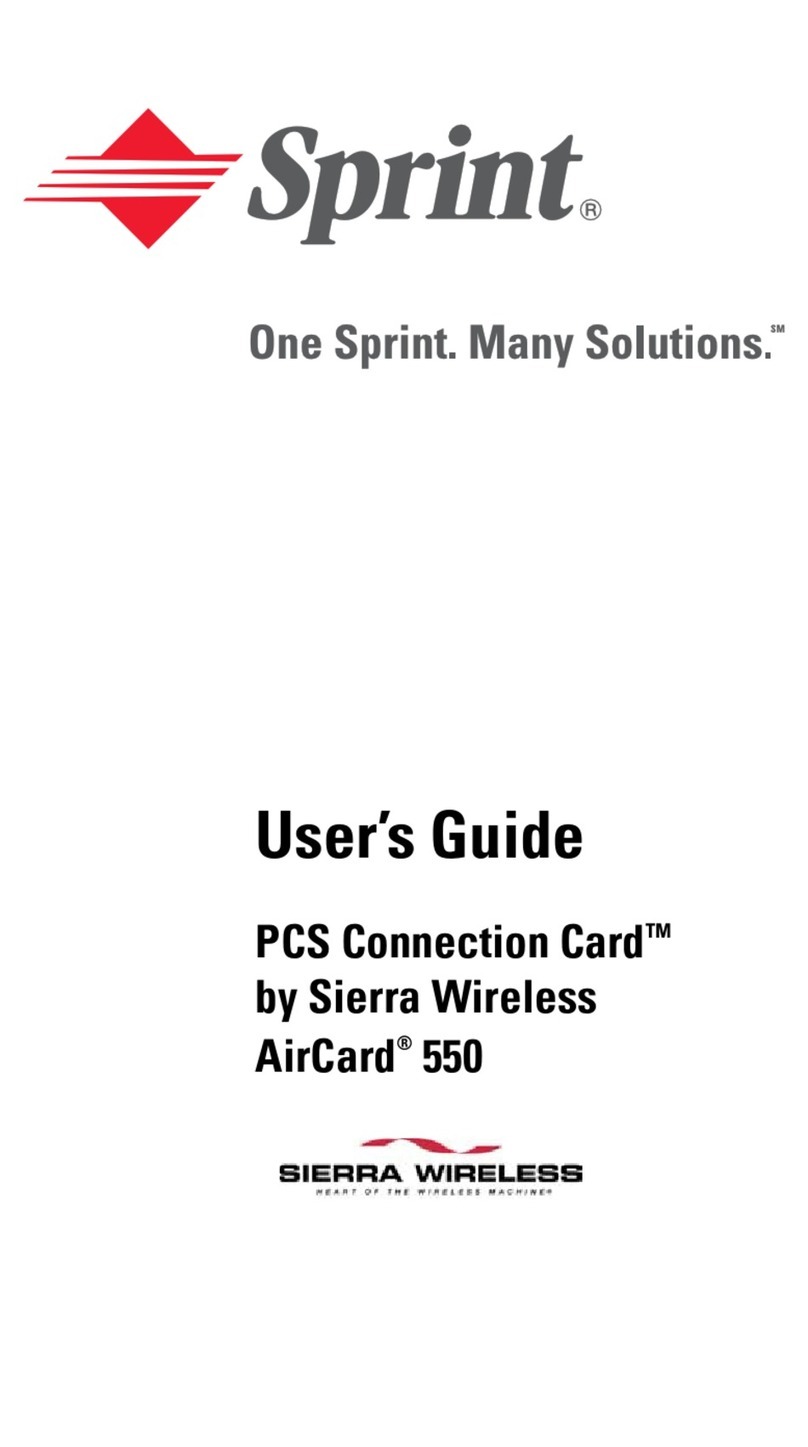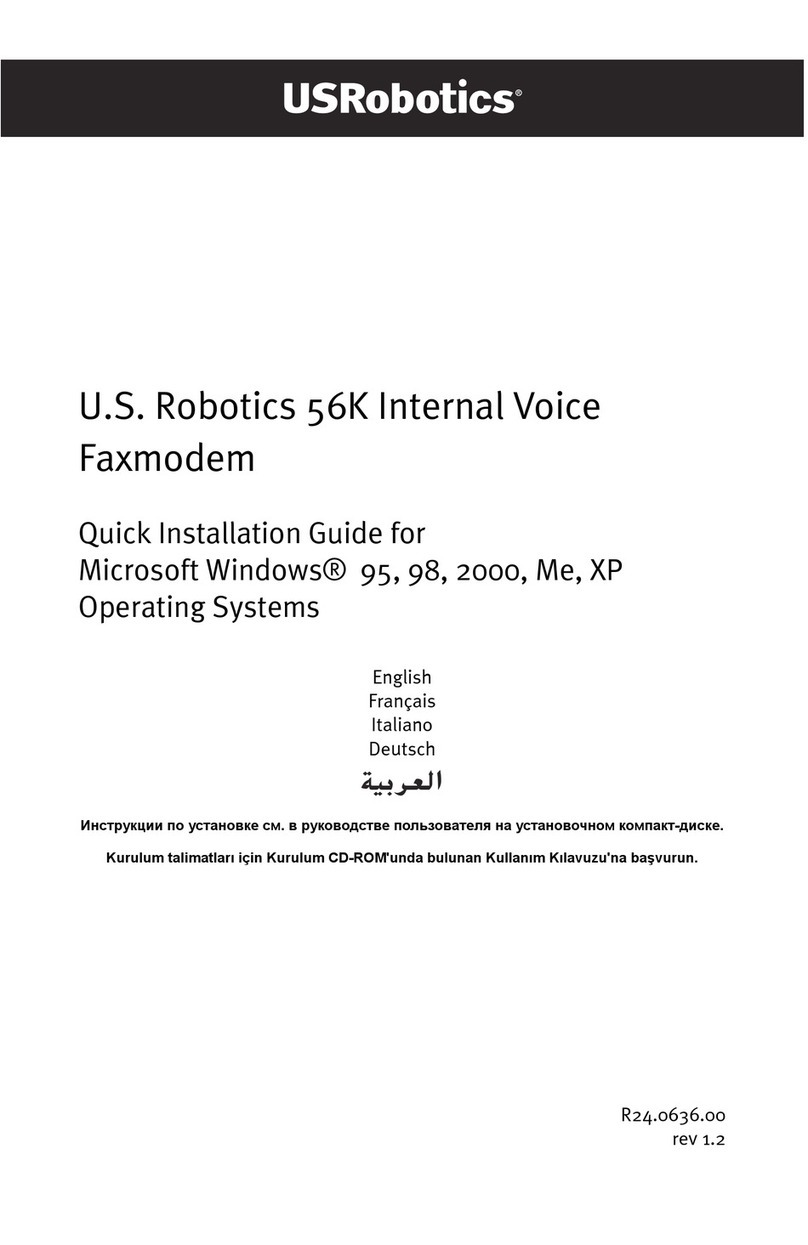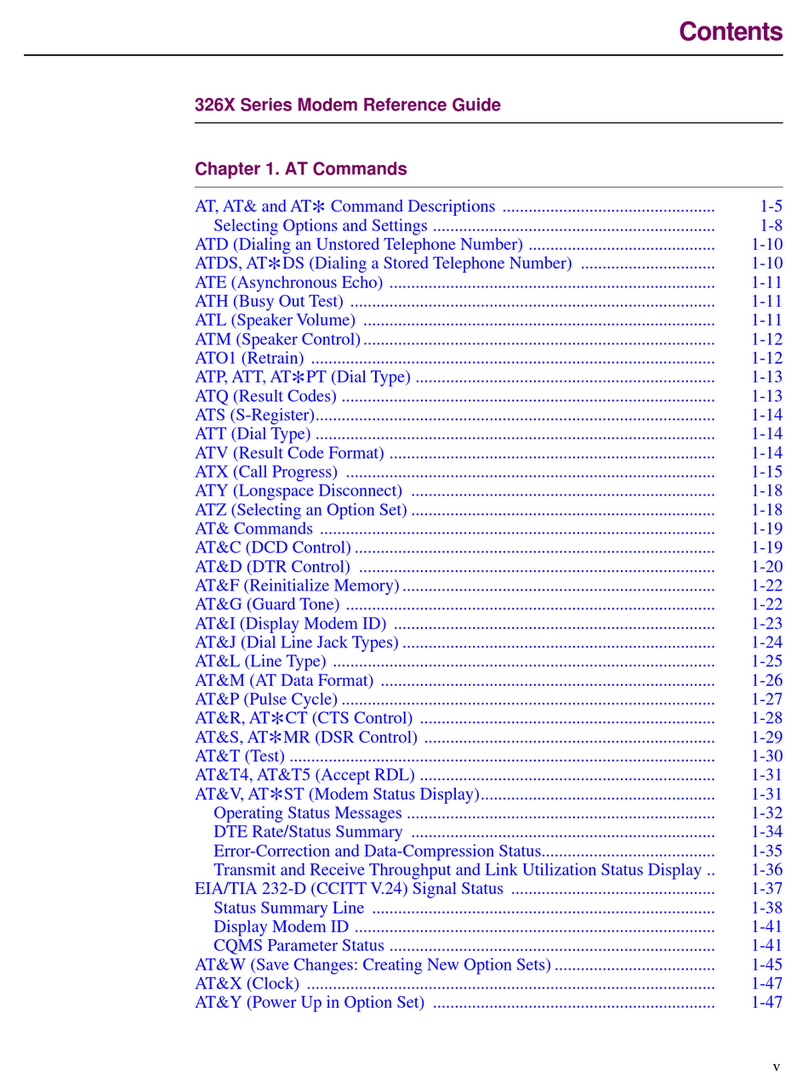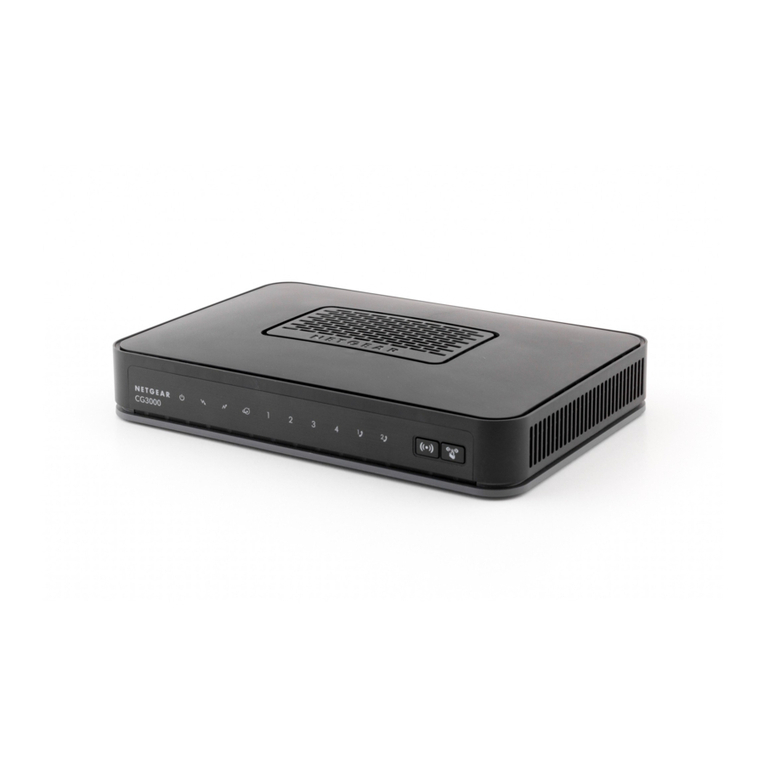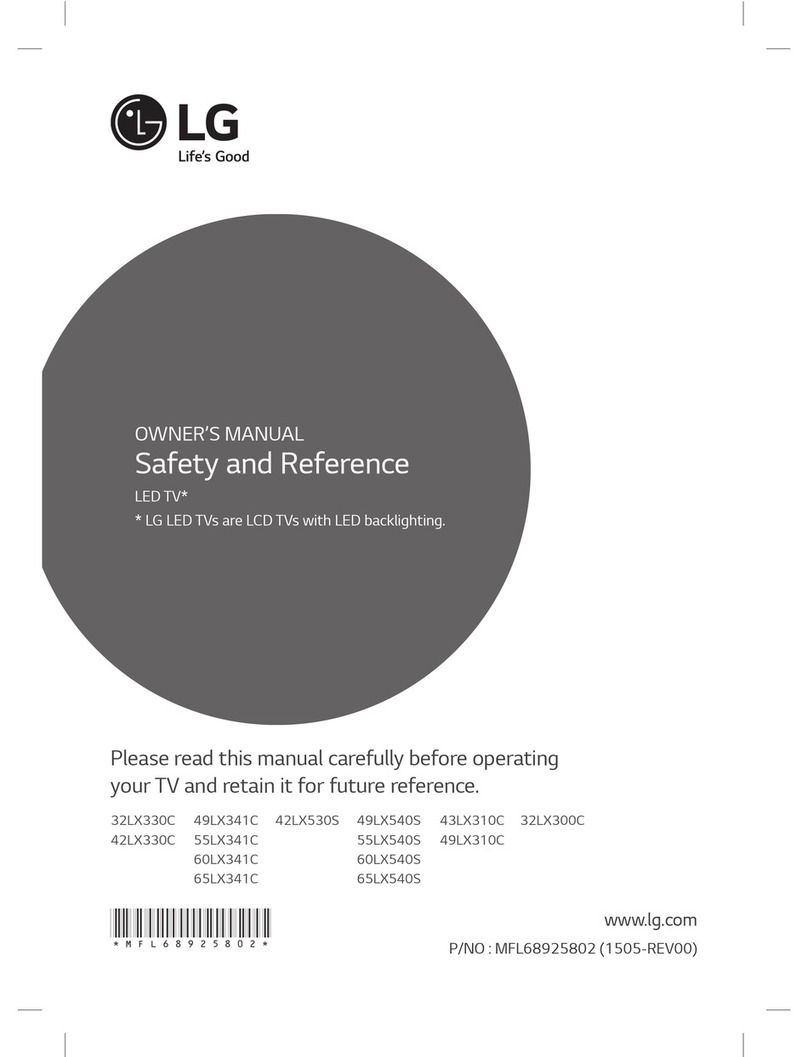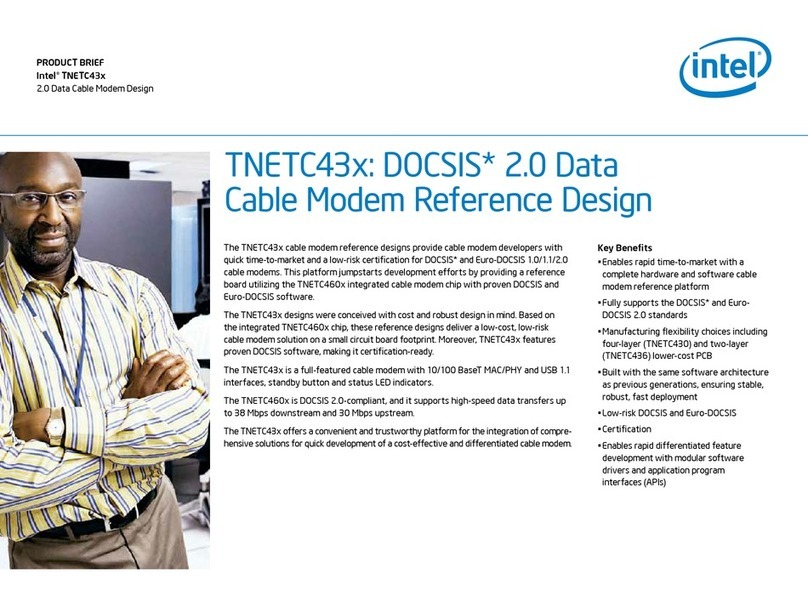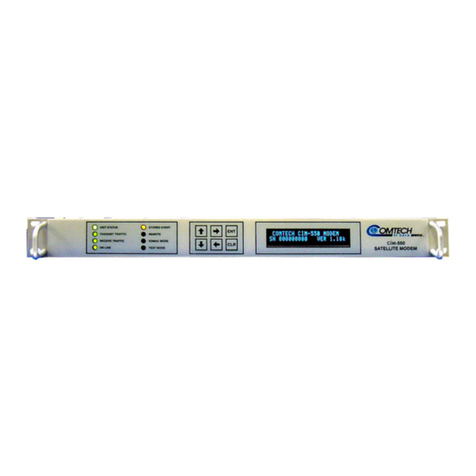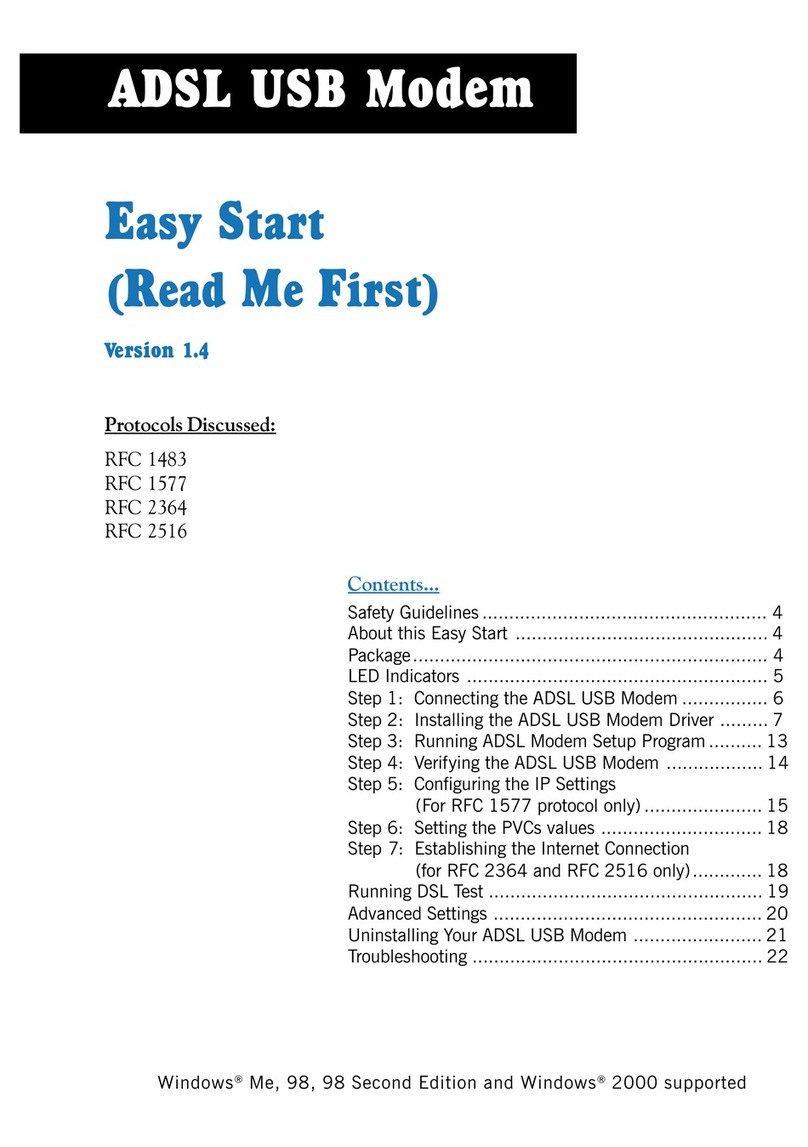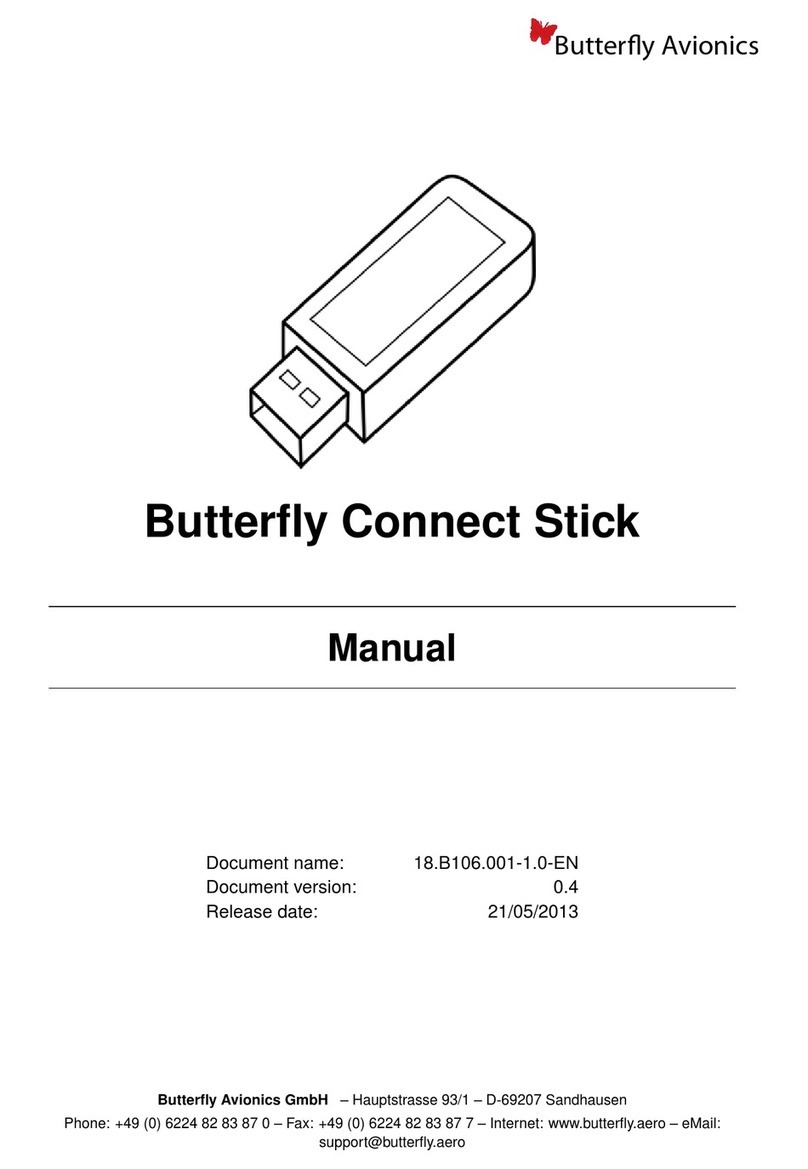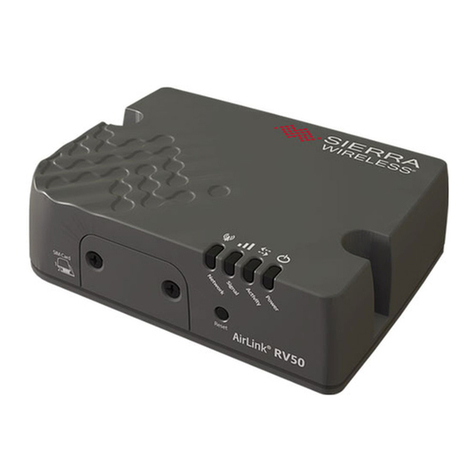GDI COMMUNICATIONS SM336 User manual

SM336
MANUAL
33.6 K SMART MODEM
Model 400 Form Factor
GDI Communications, LLC
Verdi, Nevada

© 2002 GDI Communications, LLC
SM336 MANUAL
REV. A1
GDI Communications, LLC
280 Interstate 80 Exit 1
Verdi, Nevada 89439
775-345-8000
This Manual applies to units with serial numbers 00000 and above
Drawing Number: A00687
APPROVED:
Engineering_______________________________ Date_______________
Manufacturing_____________________________ Date _______________
Marketing_________________________________ Date _______________
Release Date___________________

SM336MAN
TABLE of CONTENTS
GENERAL DESCRIPTION..........................................................................................................1
SPECIFICATIONS........................................................................................................................1
ENVIRONMENTAL.................................................................................................................1
POWER REQUIREMENTS......................................................................................................1
PHYSICAL................................................................................................................................1
MODEM....................................................................................................................................1
Compatibility:........................................................................................................................1
Transmit and Receive Frequencies:.......................................................................................2
Receiver Performance................................................................................................................2
Transmit Level...........................................................................................................................2
LINE INTERFACE ...................................................................................................................2
INDICATORS...........................................................................................................................2
INSTALLATION ..........................................................................................................................2
AT COMMAND SET SUMMARY..............................................................................................3
BASIC AT COMMANDS.........................................................................................................6
ECC COMMANDS...................................................................................................................9
MNP 10 COMMANDS.............................................................................................................9
W-CLASS COMMANDS .........................................................................................................9
CALLER ID COMMANDS......................................................................................................9
FAX CLASS 1.........................................................................................................................10
FAX CLASS 2.........................................................................................................................10
VOICE/AUDIO COMMANDS...............................................................................................11
CELLULAR COMMANDS....................................................................................................11
AUDIOSPAN AND DSVD COMMANDS............................................................................11
SYNCHRONOUS ACCESS MODE COMMANDS..............................................................11
S-REGISTERS.........................................................................................................................11
Sn - Read/Write S-Register..................................................................................................12
FACTORY DEFAULTS .....................................................................................................12
S-REGISTER DEFINITIONS.............................................................................................14
RESULT CODES ....................................................................................................................24
Tables
Table 1, DB-9 Pinout.....................................................................................................................2
Table 2, RJ-11 Pinout ....................................................................................................................2
Table 3, 170 Connections ..............................................................................................................3
Table 4, S Registers .....................................................................................................................13

SM336 Manual 1
GENERAL DESCRIPTION
The SM336 is a 33.6 Kbps dial-up modem in a
Model 400 form factor designed for use in a
Model 170 Controller.
It is completely compatible with other V.34 AT
command set modems and is specifically
designed for traffic control environments.
The SM336 is supplied with an RS-232 port that
can connect to a computer through a female DB-
9 connector located on the front of the card.
The phone line connects to the SM336 through a
standard RJ-11 connector. A second RJ-11
connector can be used to connect a telephone.
The SM336 can operate up to 33.6 Kbps and
automatically fall back to data rates as low as
300 baud.
All modem parameters such as speed, etc., can
be set and controlled using the industry standard
AT command set (see AT Command summary
beginning on page 6).
The serial port has a maximum speed of 115.2
Kbps and is RS-232 and V.24 compatible.
The SM336 cannot be used with leased lines.
Indicators on the front of the card show the
status of the modem, and include TXD, RXD,
DCD, DTR, DSR, and RI.
The SM336 also features Auto Answer, Auto
Dial, and tone or pulse dialing.
SPECIFICATIONS
ENVIRONMENTAL
Temperature Range……..-37°to +74°C
Humidity ..….5 to 95% non-Condensing
POWER REQUIREMENTS
Typical:
+12V @ 30mA (LED drive current)
+5V @ 200mA, converted from +12V supply
provided by the 170 Controller via card edge
connector, P1.
PHYSICAL
9.375”W (+ ejectors) x 6.25”H x .5” D
Weight……………~1 lb.
MODEM
Modulation……..Quadrature Amp. Mod.
Compatibility:
Modem…………ITU V.34 and Rockwell V.FC
Interface………..ITU V.24/V.28, EIA-232
Data Throughput…..115.2 Kbps
Data Rates:
33.6Kbps, 31.3Kbps, 28.8Kbps, 26.4Kbps,
24.0Kbps, 21.6Kbps, 19.2Kbps, 16.8Kbps,
14.4Kbps, 12.0Kbps, 9.6Kbps, 7.2Kbps,
4.8Kbps, 2.4Kbps, 1.2K baud, 300 baud.
The modem will automatically select the best
operating speed. Speeds are ±0.01%.
Comment [GK1]: Is this true???

2
SM336MAN
Specifications:V.34, V.32 bis, V.32, V.22
bis, V.22A/B, V.23, V.21,
Bell 212, Bell 103, V.33,
V.17, V.29, V.27 ter, V.21
Channel 2
Error Correction….V.42 LAPM, MNP2-4,
MNP 10
Data Compression…V.42 bis, MNP 5
Loop Tests…..ITU V.54 loop2 (RDL) and
Loop 3 (LAL)
Transmit and Receive Frequencies:
Data Carrier…….1800 ±0.5 Hz
Calling Tone……1300 ±10 Hz
Answering Tone…2100 ±15 Hz
Receiver Freq. Tol…….±14 Hz
Receiver Performance
S/N Ratio…………..-26 dB
Dynamic Range……-12 dBm to –42 dBm
Transmit Level
Fixed at –11 ±2 dB
Ring detect Sensitivity…. 38 VRMS
LINE INTERFACE
Ring Equiv. Number….…1 Bel
Terminating Imped………600 Ohm
Return Loss…Better than 14 dB between
200 and 4000 Hz
Table 1, DB-9 Pinout
Pin No. EIA-232
1 DCD (out)
2 RXD (out)
3 TXD (in)
4 DTR (in)
5 GND
6 DSR (out)
7 RTS (in)
8 CTS (out)
9 RI (out)
INDICATORS
TXD, RXD, DCD, DTR, DSR, RI.
The SM336 can store 2 user profiles and 4 phone
numbers. The numbers can have up to 32 digits.
INSTALLATION
The SM336 receives power from the Model 170
Controller, and the Controller should always be
powered down, or OFF for a minute or so before
inserting the SM336 into the card frame. This
should allow ample time for potentially
damaging power supply voltages to dissipate.
The incoming phone line is to be connected to
the RJ-11 connector labeled “LINE”. An external
phone can be connected to the RJ-11 labeled
“PHONE”.
Note: As the RJ11 connectors are connected in
parallel, remember not to use the phone while
the modem is in operation.
Table 2, RJ-11 Pinout
1 No connection
2 TIP
3 RING
4 No connection

SM336 Manual 3
The DB-9 connector is pinned out so that a one-
to-one cable is needed to connect to most
computers. Since most computers use a DB-9
connector with male pins, the cable will need to
have one female and one male connector on it.
The connection chart for a 170 type controller is
shown below:
Table 3, 170 Connections
Function DB-9 170 C2,20
TXD 3
K
RXD 2 L
RTS 7 J
CTS 8 M
DCD 1 H
GND 5 N
As can be seen from the Chart, the 170 doesn’t
use DTR and DSR. DTR can be set up to be
ignored by the Modem with an AT command, as
shown in the AT command summary below.
Indicators
Indicators on the front of the card give the status
of the SM336.
TXD…………Indicates that data is being
Transmitted
RXD………….Indicates that data is being
Received
DTR……….. Indicates that Data terminal
Ready is true.
DSR (OH)…..Indicates that Data SET
Ready is true. It is also
An indicator of the OFF
Hook condition.
DCD…………Indicates that the modem
Is detecting a carrier.
RI……………Indicates that the Modem is
Receiving a Ring signal.
There is no preventative maintenance required or
anything that needs to be adjusted for the life of
the product.
Switch settings:
Port B is ACIA 2 or 4 and Port A is ACIA 1 or 3 in the 170 Controller.
Function SW2 Position SW3
Port B to Smart modem section On 1 Off
“ “ On 2 Off
“ “ On 3 Off
“ “ On 4 Off
“ “ On 5 Off
“ “ On 6 Off
“ “ On 7 Off
“ “ On 8 Off

4
SM336MAN
Function SW3 Position SW2
Port A to Smart modem section On 1 Off
“ “ On 2 Off
“ “ On 3 Off
“ “ On 4 Off
“ “ On 5 Off
“ “ On 6 Off
“ “ On 7 Off
“ “ On 8 Off
Note: To configure the smart modem section using the DB-9, SW2 and SW3 should both be in the
OFF position to avoid interference with Controller data. Once configured, then either Port A or Port
B should be selected via the switches. Port A should be On for the first ACIA Port and Port B should
be On for the ACIA 2. The locations of the switches are shown below.
The following pages contain a summary of the AT Commands and “S” Registers that the SM336
responds to. The factory default settings are also shown. A complete definition of the AT commands is
too large for this Manual (174 pages). If one is required, a PDF file (450K) can be sent electronically to
you.

SM336 Manual 5

6
SM336MAN
AT COMMAND SET SUMMARY
BASIC AT COMMANDS
Command Function
A/ Re-execute command.
A Go off-hook and attempt to answer a call.
B0 Select V.22 connection at 1200 bps.
B1 Select Bell 212A connection at 1200 bps.
C1 Return OK message.
Dn Dial modifier.
E0 Turn off command echo.
E1 Turn on command echo.
H0 Initiate a hang-up sequence.
Command Function
H1 If on-hook, go off-hook and enter command mode.
I0 Report product code.
I1 Report pre-computed checksum.
I2 Report OK.
I3 Report firmware revision, model, and interface type.
I4 Report response programmed by an OEM.
I5 Report the country code parameter.
I6 Report modem data pump model and code revision.
L0 Set low speaker volume.
L1 Set low speaker volume.
L2 Set medium speaker volume.
L3 Set high speaker volume.
M0 Turn speaker off.
M1 Turn speaker on during handshaking and turn speaker off while receiving carrier.
M2 Turn speaker on during handshaking and while receiving carrier.
M3 Turn speaker off during dialing and receiving carrier and turn speaker on during answering.
N0 Turn off automode detection.
N1 Turn on automode detection.
O0 Go on-line.
O1 Go on-line and initiate a retrain sequence.
P Force pulse dialing.
Q0 Allow result codes to DTE.
Q1 Inhibit result codes to DTE.
Sn Select S-Register as default.
Sn? Return the value of S-Register n.
=v Set default S-Register to value v.
? Return the value of default S-Register.
T Force DTMF dialing.
V0 Report short form (terse) result codes.
V1 Report long form (verbose) result codes.
W0 Report DTE speed in EC mode.
W1 Report line speed, EC protocol and DTE speed.
W2 Report DCE speed in EC mode.
X0 Report basic call progress result codes, i.e., OK, CONNECT, RING, NO CARRIER (also,
for busy, if enabled, and dial tone not detected), NO ANSWER and ERROR.
X1 Report basic call progress result codes and connections speeds (OK, CONNECT, RING,
NO CARRIER (also, for busy, if enabled, and dial tone not detected), NO ANSWER,
CONNECT XXXX, and ERROR.

SM336 Manual 7
X2 Report basic call progress result codes and connections speeds, i.e., OK, CONNECT,
RING, NO CARRIER (also, for busy, if enabled, and dial tone not detected), NO ANSWER,
CONNECT XXXX, and ERROR.
X3 Report basic call progress result codes and connection rate, i.e., OK, CONNECT, RING,
NO CARRIER, NO ANSWER, CONNECT XXXX, BUSY, and ERROR.
X4 Report all call progress result codes and connection rate, i.e., OK, CONNECT, RING, NO
CARRIER, NO ANSWER, CONNECT XXXX, BUSY, NO DIAL TONE and ERROR.
Y0 Disable long space disconnect before on-hook.
Y1 Enable long space disconnect before on-hook.
Z0 Restore stored profile 0 after warm reset.
Z1 Restore stored profile 1 after warm reset.
&C0 Force RLSD active regardless of the carrier state.
&C1 Allow RLSD to follow the carrier state.
&D0 Interpret DTR ON-to-OFF transition per &Qn:
&Q0, &Q5, &Q6 The modem ignores DTR.
&Q1 The modem hangs up.
&Q2, &Q3 The modem hangs up.
Command Function
&D1 Interpret DTR ON-to-OFF transition per &Qn:
&Q0, &Q1, &Q5, &Q6 Asynchronous escape.
&Q2, &Q3 The modem hangs up.
&D2 Interpret DTR ON-to-OFF transition per &Qn:
&Q0 through &Q6 The modem hangs up.
&D3 Interpret DTR ON-to-OFF transition per &Qn:.
&Q0, &Q1, &Q5, &Q6 The modem performs soft reset.
&Q2, &Q3 The modem hangs up.
&F0 Restore factory configuration 0.
&F1 Restore factory configuration 1.
&G0 Disable guard tone.
&G1 Disable guard tone.
&G2 Enable 1800 Hz guard tone.
&K0 Disable DTE/DCE flow control.
&K3 Enable RTS/CTS DTE/DCE flow control.
&K4 Enable XON/XOFF DTE/DCE flow control.
&K5 Enable transparent XON/XOFF flow control.
&K6 Enable both RTS/CTS and XON/XOFF flow control.
&L0 Select dial up line operation.
&M0 Select direct asynchronous mode.
&M1 Select sync connect with async off-line command mode. *
&M2 Select sync connect with async off-line command mode and enable DTR dialing of
directory zero. *
&M3 Select sync connect with async off-line command mode and enable DTR to act as
Talk/Data switch. *
&P0 Set 10 pps pulse dial with 39%/61% make/break.
&P1 Set 10 pps pulse dial with 33%/67% make/break.
&P2 Set 20 pps pulse dial with 39%/61% make/break.
&P3 Set 20 pps pulse dial with 33%/67% make/break.
&Q0 Select direct asynchronous mode.
&Q1 Select sync connect with async off-line command mode. *
&Q2 Select sync connect with async off-line command mode and enable DTR dialing of
directory zero. *
&Q3 Select sync connect with async off-line command mode and enable DTR to act as
Talk/Data switch. *
&Q5 Modem negotiates an error corrected link.
&Q6 Select asynchronous operation in normal mode.
&R0 CTS tracks RTS (async) or acts per V.25 (sync).

8
SM336MAN
&R1 CTS is always active.
&S0 DSR is always active.
&S1 DSR acts per V.25.
&T0 Terminate any test in progress.
&T1 Initiate local analog loopback.
&T2 Returns ERROR result code.
&T3 Initiate local digital loopback.
&T4 Allow remote digital loopback.
&T5 Disallow remote digital loopback request.
&T6 Request an RDL without self-test.
&T7 Request an RDL with self-test.
&T8 Initiate local analog loop with self-test.
&V Display current configurations.
&V1 Display connection statistics.
&W0 Store the active profile in NVRAM profile 0.
&W1 Store the active profile in NVRAM profile 1.
&X0 Select internal timing for the transmit clock.
Command Function
&X1 Select external timing for the transmit clock.
&X2 Select slave receive timing for the transmit clock.
&Y0 Recall stored profile 0 upon power up.
&Y1 Recall stored profile 1 upon power up.
&Zn=x Store dial string x (to 34) to location n (0 to 3).
%E0 Disable line quality monitor and auto retrain.
%E1 Enable line quality monitor and auto retrain.
%E2 Enable line quality monitor and fallback/fall forward.
%L Return received line signal level.
%Q Report the line signal quality.
%U Select µ-Law or A-Law codec type.
%7 Plug and Play serial number.
%8 Plug and Play vendor ID and product number.
\Kn Controls break handling during three states:
When modem receives a break from the DTE:
\K0,2,4 Enter on-line command mode, no break sent to the remote modem.
\K1 Clear buffers and send break to remote modem.
\K3 Send break to remote modem immediately.
\K5 Send break to remote modem in sequence with transmitted data.
When modem receives \B in on-line command state:
\K0,1 Clear buffers and send break to remote modem.
\K2,3 Send break to remote modem immediately.
\K4,5 Send break to remote modem in sequence with transmitted data.
When modem receives break from the remote modem:
\K0,1 Clear data buffers and send break to DTE.
\K2,3 Send a break immediately to DTE.
\K4,5 Send a break with received data to the DTE.
\N0 Select normal speed buffered mode.
\N1 Select direct mode.
\N2 Select reliable link mode.
\N3 Select auto reliable mode.
\N4 Force LAPM mode.
\N5 Force MNP mode.
\V0 Connect messages are controlled by the command settings X, W, and S95.
\V1 Connect messages are displayed in the single line format.
+MS Select modulation.

SM336 Manual 9
+H0 Disable RPI/Video Ready Mode.
+H1 Enable RPI and set DTE speed to 19200 bps.
+H2 Enable RPI and set DTE speed to 38400 bps.
+H3 Enable RPI and set DTE speed to 57600 bps.
+H11 Enable RPI+ mode.
+H16 Enable video ready mode.
+H17 Enable host-based DSVD.
** Load flash memory.
-SDR=0 Disable Distinctive Ring.
-SDR=1 Enable Distinctive Ring Type 1.
-SDR=2 Enable Distinctive Ring Type 2.
-SDR=3 Enable Distinctive Ring Type 1 and 2.
-SDR=4 Enable Distinctive Ring Type 3.
-SDR=5 Enable Distinctive Ring Type 1 and 3.
-SDR=6 Enable Distinctive Ring Type 2 and 3.
Command Function
-SDR=7 Enable Distinctive Ring Type 1, 2, and 3.
ECC COMMANDS
Command Function
%C0 Disable data compression.
%C1 Enable MNP 5 data compression.
%C2 Enable V.42 bis data compression.
%C3 Enable both V.42 bis and MNP 5 compression.
\A0 Set maximum block size in MNP to 64.
\A1 Set maximum block size in MNP to 128.
\A2 Set maximum block size in MNP to 192.
\A3 Set maximum block size in MNP to 256.
\Bn Send break of n x 100 ms.
MNP 10 COMMANDS
Command Function
-K0 Disable MNP 10 extended services.
-K1 Enable MNP 10 extended services.
-K2 Enable MNP 10 extended services detection only.
-SEC=0 Disable MNP10-EC.
-SEC=1,[<tx level>] Enable MNP10-EC and set transmit level <tx level> 0 to 30 (0 dBm to -30 dBm).
W-CLASS COMMANDS
Command Function
*B Display list of permanently blacklisted numbers.
*D Display list of delayed numbers.
*NCn Change country to one of eight in NVRAM.
CALLER ID COMMANDS
Command Function
#CID=0 Disable Caller ID.
#CID=1 Enable Caller ID with formatted presentation.
#CID=2 Enable Caller ID with unformatted presentation.

10
SM336MAN
FAX CLASS 1
Command Function
+FCLASS=n Service class.
+FAE=n Data/fax auto answer
+FRH=n Receive data with HDLC framing.
+FRM=n Receive data.
+FRS=n Receive silence.
+FTH=n Transmit data with HDLC framing.
+FTM=n Transmit data.
+FTS=n Stop transmission and wait.
FAX CLASS 2
Command Function
+FCLASS=n Service class.
Command Function
+FAA=n Adaptive answer.
+FAXERR Fax error value.
+FBOR Phase C data bit order.
+FBUF? Buffer size (read only).
+FCFR Indicate confirmation to receive.
+FCLASS= Service class.
+FCON Facsimile connection response.
+FCIG Set the polled station identification.
+FCIG: Report the polled station identification.
+FCR Capability to receive.
+FCR= Capability to receive.
+FCSI: Report the called station ID.
+FDCC= DCE capabilities parameters.
+FDCS: Report current session.
+FDCS= Current session results.
+FDIS: Report remote capabilities.
+FDIS= Current sessions parameters.
+FDR Begin or continue phase C receive data.
+FDT= Data transmission.
+FDTC: Report the polled station capabilities.
+FET: Post page message response.
+FET=N Transmit page punctuation.
+FHNG Call termination with status.
+FK Session termination.
+FLID= Local ID string.
+FLPL Document for polling.
+FMDL? Identify model.
+FMFR? Identify manufacturer.
+FPHCTO Phase C time out.
+FPOLL Indicates polling request.
+FPTS: Page transfer status.
+FPTS= Page transfer status.
+FREV? Identify revision.
+FSPL Enable polling
+FTSI: Report the transmit station ID.

SM336 Manual 11
VOICE/AUDIO COMMANDS
Command Function
#BDR Select baud rate (turn off autobaud).
#CLS Select data, fax, or voice.
#MDL? Identify model.
#MFR? Identify manufacturer.
#REV? Identify revision level.
#SPK= Speakerphone setting.
#TL Audio output transmit level.
#VBQ? Query buffer size.
#VBS Bits per sample.
#VBT Beep tone timer.
#VCI? Identify compression method.
#VGT Set playback volume in the command state.
#VLS Voice line select.
#VRA Ringback goes away timer (originate).
#VRN Ringback never came timer (originate).
#VRX Voice receive mode.
Command Function
#VSD Enable silence deletion (no function, command response only).
#VSK Buffer skid setting.
#VSP Silence detection period (voice receive).
#VSR Sampling rate selection.
#VSS Silence detection tuner (voice receive).
#VTD DTMF/tone reporting.
#VTM Enable timing mark placement.
#VTS Generate tone signals.
#VTX Voice transmit mode.
CELLULAR COMMANDS
Command Function
^C2 Download cellular phone driver.
^I Identify cellular phone driver.
^T6 Indicate status of cellular phone.
AUDIOSPAN AND DSVD COMMANDS
Command Function
-SMS= Select AudioSpan/DSVD Mode
SYNCHRONOUS ACCESS MODE COMMANDS
Command Function
+ES Enables and disables Synchronous Access Mode in the client or central site modem
+ESA Configures the operation of the Synchronous Access Submode
+ITF Selects Transmit Flow Control Thresholds
S-REGISTERS
The S-Registers are summarized in the following table along with their default values; registers denoted with an '*' may be
stored in one of the two user profiles by entering the &Wn command. One of these profiles may be loaded at any time by
using the Zn command. Registers or register fields quoted as “reserved” are reserved for current or future use by the

12
SM336MAN
firmware, or are permanently overridden by PTT limitations. For the latter, control of the equivalent functionality is available
with ConfigurACE Call Progress and Blacklisting options.
All bit-mapped registers are read-only. The appropriate AT command which controls the relevant bits in the S-Register
should be used to change the value.
Sn - Read/Write S-Register
The modem selects an S-Register, performs an S-Register read or write function, or reports the value of an S-Register.
n Establishes S-Register n as the last register accessed.
n=v Sets S-Register n to the value v.
n? Reports the value of S-Register n.
The parameter n can be omitted, in which case the last S-Register accessed will be assumed. The S can be omitted for AT=
and AT?, in which case the last S-Register accessed will be assumed.
For example:
ATS7 establishes S7 as the last accessed register.
AT=40 sets the contents of the last register accessed to 40.
ATS=20 sets the contents of the last register accessed to 20.
If the number "n" is beyond the range of the S-Registers available, the modem will return the ERROR message. The value
"v" is "MOD"ed with 256. If the result is outside the range permitted for a given S-Register the values will still be stored, but
functionally the lower and higher limits will be observed. Input and output are always in decimal format. Note that some S-
Registers are read-only.
In some cases, writing to the S-Register will appear to be accepted but the value will not actually be written.
Due to country restrictions, some commands will be accepted, but the value may be limited and replaced by a maximum or
minimum value.
Minimum, maximum, and default values for S-Registers may be altered with ConfigurACE.
FACTORY DEFAULTS
The factory default values are stored in ROM and are loaded into the active configuration at power up or by the ATZn
command. In addition, the designated default profile is subsequently loaded, and may change some of the factory default
values. The designated default profile can be changed by entering the &Yn command where n is one of the two possible user
profiles.
The defaults shown are those used by Rockwell in factory profiles zero and one. These may be overwritten by the OEM with
ConfigurACE prior to placing the firmware in PROM. Minimum and maximum values may also be imposed by
ConfigurACE in response to country PTT requirements.
The default values shown in Table 3-1 may vary by modem firmware configuration. Consult the MCU firmware release notes
for exact configuration.
The factory default values may be loaded at any time by entering the &Fn command.

SM336 Manual 13
Table 4, S Registers
S Registers
Register Function Range Units Saved Default**
S0 Rings to Auto-Answer 0-255 rings * 0
S1 Ring Counter 0-255 rings 0
S2 Escape Character 0-255 ASCII * 43
S3 Carriage Return Character 0-127 ASCII 13
S4 Line Feed Character 0-127 ASCII 10
S5 Backspace Character 0-255 ASCII 8
S6 Wait Time for Dial Tone 2-255 s * 2
S7 Wait Time for Carrier 1-255 s * 50
S8 Pause Time Dial Delay Modifier 0-255 s * 2
S9 Carrier Detect Response Time 1-255 0.1s * 6
S10 Carrier Loss Disconnect Time 1-255 0.1s * 14
S11 DTMF Tone Duration 50-255 0.001s * 95
S12 Escape Prompt Delay 0-255 0.02s * 50
S14 General Bit Mapped Options Status - - * 138 (8Ah)
S16 Test Mode Bit Mapped Options Status (&T) - - 0
S18 Test Timer 0-255 s * 0
S19 AutoSync Options - - 0
S20 AutoSync HDLC Address or BSC Sync Character - - * 0
S21 V.24/General Bit Mapped Options Status - - * 52 (34h)
S22 Speaker/Results Bit Mapped Options Status - - * 117 (75h)
S23 General Bit Mapped Options Status - * 62 (3Dh)
S24 Sleep Inactivity Timer 0-255 s * 0
S25 Delay to DTR Off 0-255 s or 0.01s 5
S26 RTS-to-CTS Delay 0-255 0.01s 1
S27 General Bit Mapped Options Status - - * 73 (49h)
S28 General Bit Mapped Options Status - - * 0
S29 Flash Dial Modifier Time 0-255 10ms 70
S30 Disconnect Inactivity Timer 0-255 10s 0
S31 General Bit Mapped Options Status - - * 194 (C2h)
S32 XON Character 0-255 ASCII 17 (11h)
S33 XOFF Character 0-255 ASCII 19 (13h)
S36 LAPM Failure Control - - * 7
S37 Line Connection Speed - - * 0
S38 Delay Before Forced Hangup 0-255 s 20
S39 Flow Control Bit Mapped Options Status - - * 3
S40 General Bit Mapped Options Status - - * 104 (68h)
S41 General Bit Mapped Options Status - - * 195 (C3h)
S46 Data Compression Control - - * 138
S48 V.42 Negotiation Control - - * 7
S82 LAPM Break Control - - 128 (40h)
S86 Call Failure Reason Code 0-255 - -
S91 PSTN Transmit Attenuation Level 0-15 dBm 10 (Country dependent)
S92 Fax Transmit Attenuation Level 0-15 dBm 10 (Country dependent)
S95 Result Code Messages Control - - * 0
* Register value may be stored in one of two user profiles with the &W command.
** Default values may be modified using ConfigurACE.

14
SM336MAN
S-REGISTER DEFINITIONS
S0 - Number of Rings to Auto-Answer
S0 sets the number of the rings required before the modem automatically answers a call. Setting this register to zero disables
auto-answer mode.
Range: 0-255 rings
Default: 0
S1 - Ring Counter
S1 is incremented each time the modem detects a ring signal on the telephone line. S1 is cleared if no rings occur over an
eight second interval.
Range: 0-255 rings
Default: 0
S2 - Escape Character
S2 holds the decimal value of the ASCII character used as the escape character. The default value corresponds to an ASCII
'+'. A value over 127 disables the escape process, i.e., no escape character will be recognized.
Range: 0-255, ASCII decimal
Default: 43 (+)
S3 - Carriage Return Character
S3 sets the command line and result code terminator character. Pertains to asynchronous operation only.
Range: 0-127, ASCII decimal
Default: 13 (Carriage Return)
S4 - Line Feed Character
S4 sets the character recognized as a line feed. Pertains to asynchronous operation only. The Line Feed control character is
output after the Carriage Return control character if verbose result codes are used.
Range: 0-127, ASCII decimal
Default: 10 (Line Feed)
S5 - Backspace Character
S5 sets the character recognized as a backspace. Pertains to asynchronous operation only. The modem will not recognize
the Backspace character if it is set to a value that is greater than 32 ASCII. This character can be used to edit a command
line. When the echo command is enabled, the modem echoes back to the local DTE the Backspace character, an ASCII
space character and a second Backspace character; this means a total of three characters are transmitted each time the
modem processes the Backspace character.
Range: 0-32, ASCII decimal
Default: 8 (Backspace).
S6 - Wait Time before Blind Dialing or for Dial Tone
S6 operation is country dependent.
1. Sets the length of time, in seconds, that the modem will wait before starting to dial after going off-hook when
blind dialing. This operation, however, may be affected by some ATX options according to country restrictions.
The “Wait for Dial Tone” call progress feature (W dial modifier in the dial string) will override the value in
register S6. (US models.)
2. Sets the length of time, in seconds, that the modem will wait for dial tone when encountering a “W” dial
modifier before returning NO DIAL TONE result code. (W class.)

SM336 Manual 15
The modem always pauses for a minimum of 2 seconds, even if the value of S6 is less than 2 seconds.
Range: 2-255 seconds
Default: 2
S7 - Wait Time for Carrier, Silence, or Dial Tone
S7 operation is country dependent.
1. Sets the length of time, in seconds, that the modem will wait for carrier before hanging up. The timer is started
when the modem finishes dialing (originate), or 2 seconds after going off-hook (answer). In originate mode, the
timer is reset upon detection of answer tone if allowed by country restrictions.
2. Sets the length of time, in seconds, that modem will wait for silence when encountering the @ dial modifier
before continuing with the next dial string parameter.
3. Sets the length of time, in seconds, that the modem will wait for dial tone when encountering a “W” dial
modifier before continuing with the next dial string parameter. (US models.)
Range: 1-255 seconds
Default: 50
S8 - Pause Time For Dial Delay
S8 sets the time, in seconds, that the modem must pause when the “,” dial modifier is encountered in the dial string.
Range: 0-255 seconds
Default: 2
S9 - Carrier Detect Response Time
S9 is supported for backwards compatibility only. No value can be written. Responds with default value.
Range: 6 tenths of a second
Default: 6 (0.6 second)
S10 - Lost Carrier To Hang Up Delay
S10 sets the length of time, in tenths of a second, that the modem waits before hanging up after a loss of carrier. This allows
for a temporary carrier loss without causing the local modem to disconnect. When register S10 is set to 255, the modem
functions as if a carrier is always present.
The actual interval the modem waits before disconnecting is the value in register S10 minus the value in register S9.
Therefore, the S10 value must be greater than the S9 value or else the modem disconnects before it recognizes the carrier.
Range: 1-255 tenths of a second
Default: 14 (1.4 seconds)
Note: For Call Waiting detection, if the modem is set to US country code and S10 >=16, then the modem will detect the Call
Waiting tone and hang-up the line. If S10 <16, the modem will not detect Call Waiting tone.
S11 - DTMF Tone Duration
S11 operation is country dependent.
1. For US models, S11 sets the duration of tones in DTMF dialing (has no effect on pulse dialing).
2. For W-class models, S11 is a country parameter loaded by ConfigurACE.
Range: 50-255 milliseconds
Default: 95 (95 milliseconds)

16
SM336MAN
S12 - Escape Prompt Delay (EPD)
S12 defines the maximum period, in fiftieths of a second, allowed between receipt of the last character of the three escape
character sequence from the DTE and sending of the OK result code to the DTE. If any characters are detected during this
time, the OK will not be sent. Note that sending of the OK result code does not affect entry into command mode. (See 3.1.3.)
Range: 0-255 1/50 of a second
Default: 50 (1 second)
S14 - General Bit Mapped Options Status
S14 indicates the status of command options.
Default: 138 (8Ah) (10001010b)
Bit 0 This bit is ignored.
Bit 1 Command echo (En)
0 = Disabled (E0)
1 = Enabled (E1) (Default.)
Bit 2 Quiet mode (Qn)
0 = Send result codes (Q0) (Default.)
1 = Do not send result codes (Q1)
Bit 3 Result codes (Vn)
0 = Numeric (V0)
1 = Verbose (V1) (Default.)
Bit 4 Reserved
Bit 5 Tone (T)/Pulse (P)
0 = Tone (T) (Default.)
1 = Pulse (P)
Bit 6 Reserved
Bit 7 Originate/Answe
r
0 = Answe
r
1 = Originate (Default.).
S16 - General Bit Mapped Test Options Status
S16 indicates the test in progress status.
Default: 0
Bit 0 Local analog loopback
0 = Disabled (Default.)
1 = Enabled (&T1)
Bit 1 Not used
Bit 2 Local digital loopback
0 = Disabled (Default.)
1 = Enabled (&T3)
Bit 3 Remote digital loopback (RDL) status
0 = Modem not in RDL (Default.)
1 = RDL in progress
Bit 4 RDL requested (AT&T6)
0 = RDL not requested (Default.)
1 = RDL requested (&T6)
Bit 5 RDL with self test
0 = Disabled (Default.)
1 = Enabled (&T7)
Bit 6 Local analog loopback (LAL) with self test

SM336 Manual 17
0 = Disabled (Default.)
1 = Enabled (&T8)
Bit 7 Not used
S18 - Test Timer
S18 sets the length of time, in seconds, that the modem conducts a test (commanded by &Tn) before returning to the
command mode. If this register value is zero, the test will not automatically terminate; the test must be terminated from the
command mode by issuing an &T0 or H command. When S18 is non-zero, the modem returns the OK message upon test
termination. Range: 0-255 seconds
Default: 0
S19 - AutoSync Bit Mapped Options
S19 is supported for backwards compatibility only. No value can be written. Responds with default value.
Range: None
Default: 0
S20 - AutoSync HDLC Address or BSC Sync Character
S20 is supported for backwards compatibility only. No value can be written. Responds with default value.
Range: None
Default: 0.
S21 - V.24/General Bit Mapped Options Status
S21 indicates the status of command options.
Default: 52 (34h) (00110100b)
Bit 0 Reserved (0)
Bit 1 Reserved (0)
Bit 2 CTS behavior (&Rn)
0 = CTS tracks RTS (&R0)
1 = CTS always on (&R1) (Default.)
Bits 3-4 DTR behavior (&Dn)
0 = &D0 selected
1 = &D1 selected
2 = &D2 selected (Default.)
3 = &D3 selected
Bit 5 RLSD (DCD) behavior (&Cn)
0 = &C0 selected
1 = &C1 selected (Default.)
Bit 6 DSR behavior (&Sn)
0 = &S0 selected (Default.)
1 = &S1 selected
Bit 7 Long space disconnect (Yn)
0 = Y0 (Default.)
1 = Y1
S22 - Speaker/Results Bit Mapped Options Status
S22 indicates the status of command options.
Default: 117 (75h) (01110101b)
Table of contents
Other GDI COMMUNICATIONS Modem manuals
